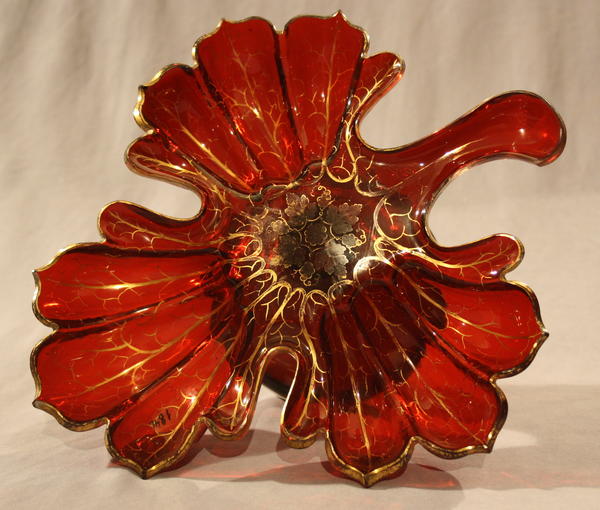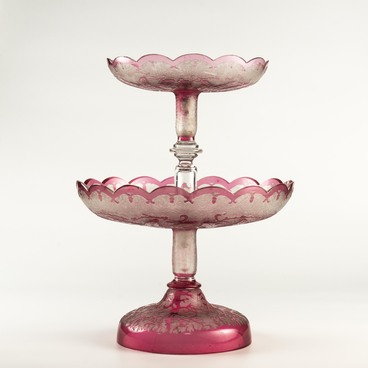The “Leaf” vase displayed in the museum was produced in 1891. It was made of two-layer glass (colorless and dark red) and decorated using liquid gold solutions.
The Dyatkovo Crystal Factory was founded and, until 1918, owned by the Maltsovs, a family of industrialists. According to his contemporaries, Ivan Maltsov placed high emphasis on improving the glass production technique. He mastered all the innovative methods of crystal painting. In particular, he is credited with developing the production of ruby glass that was painted with copper instead of gold.
The copper ruby color is achieved by adding a copper oxide that gives the glass its rich and unique dark-ruby color. The copper ruby glass was invented by Mikhail Lomonosov, the first Russian natural scientist and one of the founders of physical chemistry. In the reducing conditions of glass melting, when metallic copper particles are reduced and emitted from the copper compounds, the glass takes on a red color. The copper ruby color is very dark, and a thick layer of painted glass may even seem black. The copper ruby is used for producing overlay glass. The process of making such glass is one of the most complicated operations in the melting workshop — it is carried out on the bench directly at the furnace. Even the simplest colored overlay glass requires the craftsman to have a good sense of color: the only way to assess the amount of glass needed for a particular shade is to estimate it by eye which is very difficult.
A vivid example of this production and painting technique is the “Leaf” table vase. The vase belongs to the Art Nouveau style that was incredibly popular in late 19th century Russia. It resembles a maple or vine leaf of a beautiful claret red color that conjures up the images of a warm Indian summer when the plants take on their vivid colors. The veins of the leaf are skillfully painted in gold and shine brightly, reflecting the light.
The Dyatkovo Crystal Factory was founded and, until 1918, owned by the Maltsovs, a family of industrialists. According to his contemporaries, Ivan Maltsov placed high emphasis on improving the glass production technique. He mastered all the innovative methods of crystal painting. In particular, he is credited with developing the production of ruby glass that was painted with copper instead of gold.
The copper ruby color is achieved by adding a copper oxide that gives the glass its rich and unique dark-ruby color. The copper ruby glass was invented by Mikhail Lomonosov, the first Russian natural scientist and one of the founders of physical chemistry. In the reducing conditions of glass melting, when metallic copper particles are reduced and emitted from the copper compounds, the glass takes on a red color. The copper ruby color is very dark, and a thick layer of painted glass may even seem black. The copper ruby is used for producing overlay glass. The process of making such glass is one of the most complicated operations in the melting workshop — it is carried out on the bench directly at the furnace. Even the simplest colored overlay glass requires the craftsman to have a good sense of color: the only way to assess the amount of glass needed for a particular shade is to estimate it by eye which is very difficult.
A vivid example of this production and painting technique is the “Leaf” table vase. The vase belongs to the Art Nouveau style that was incredibly popular in late 19th century Russia. It resembles a maple or vine leaf of a beautiful claret red color that conjures up the images of a warm Indian summer when the plants take on their vivid colors. The veins of the leaf are skillfully painted in gold and shine brightly, reflecting the light.



